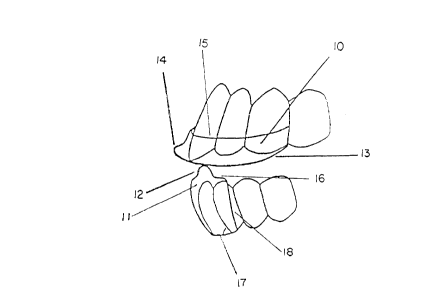Note: Claims are shown in the official language in which they were submitted.
THE EMBODIMENTS OF THE INVENTION IN WHICH AN EXCLUSIVE PROPERTY
OR PRIVILEGE IS CLAIMED ARE DEFINED AS FOLLOWS:
1. A custom, two piece, intra-oral apparatus which reduces muscle contraction, comprising:
an upper part which fits over, and is closely adapted to, preferably, the maxillary front six teeth
forming a smooth, flat platform whose anterior border follows the curvature of the teeth and
extends beyond their labial surfaces to a distance slightly beyond that to which the patient is able
to bring the dome of the lower part of the apparatus when fully protruding their mandible, with a
posterior border running across the palate from cuspid to cuspid;
a lower part which fits over, and is closely adapted to, usually, the lower four incisor teeth with a small
dome located on its upper surface over the longitudinal axis of the two central incisors at the
midline, in such a manner that when the upper and lower teeth are closed together, the dome
engages the flat platform of the upper part of the apparatus thus preventing any contact of the
posterior teeth, and causing the forces exerted by the elevator muscles of the mandible to be
directed down through the long axes of the lower incisor teeth.
2. An intra-oral apparatus as claimed in claim 1, wherein the actual number of maxillary teeth
covered can vary, because that is not an essential element of the invention.
3. An intra-oral apparatus as claimed in claims 1 and 2, wherein the anterior border of the upper
part of the apparatus completely covers the labial surfaces of the maxillary teeth.
4. An intra-oral apparatus as claimed in claims 1, 2 and 3, wherein the shape and placement of the
posterior border of the upper part of the apparatus can vary depending on the number of teeth
incorporated in the apparatus.
5. An intra-oral apparatus as claimed in claims 1, 2, 3 and 4, wherein the shape of the raised dome of
the lower part of the apparatus is not defined because shape is not the essential element; it is the
location and the fact that it is raised which are the essential elements.
6. An intra-oral apparatus as claimed in claims 1, 2, 3, 4 and 5, wherein the lower part of the
apparatus has flanges extending laterally from the front and/or back surfaces, following the
curvature of the arch of the teeth.
7. An intra-oral apparatus as claimed in claims 1, 2, 3, 4, 5 and 6, wherein wire extensions extend
laterally from either or both sides of the body of the lower part of the apparatus.
8. An intra-oral apparatus as claimed in claims 1, 2, 3, 4, 5, 6 and 7, wherein stainless steel wire or
orthodontic wire clasps are added on either the upper or lower or both parts of the apparatus to
aid in retention
9. An intra-oral apparatus as claimed in claims 1, 2, 3, 4, 5, 6, 7, and 8 wherein a vinyl resin is used
to construct the apparatus instead of methylmethacrylate.
10. An intra-oral apparatus as claimed in claims 1, 2, 3, 4, 5, 6, 7 and 8, wherein a light cured resin is
used to construct the apparatus instead of methylmethacrylate.
11. An intra-oral apparatus as claimed in claims 1, 2, 3, 4, 5, 6, 7 and 8, wherein a silicone material is
used to construct the apparatus instead of methylmethacrylate.
12. An intra-oral apparatus as claimed in claims 1, 2, 3, 4, 5, 6, 7 and 8, wherein the material of
construction of the apparatus is not an essential element.
13. An intra-oral apparatus as claimed in claims 1, 2, 3, 4, 5, 6, 7, 8, 9, 10, 11 and 12, wherein a soft
lining material which is actually an integral part of the apparatus is placed between the apparatus
and the teeth to act as a gasket to aid in retention.
14. An intra-oral apparatus as claimed in claims 1, 2, 3, 4, 5, 6, 7, 8, 9, 10, 11 and 12, wherein the
material of construction of the apparatus is a two part hard/soft acrylic material with the soft part
on the inside ( or fitting side) of the apparatus to aid in retention, surrounded on the outside by
the hard acrylic.
15. The method of reducing the intensity of muscle contraction of the elevator muscles of the
mandible and hence the incidence of headache pain, by means of the construction and fitting of the
custom, intra-oral apparatus described, to be worn by the patient while asleep, or at other times
considered appropriate, but not to be worn while eating.
